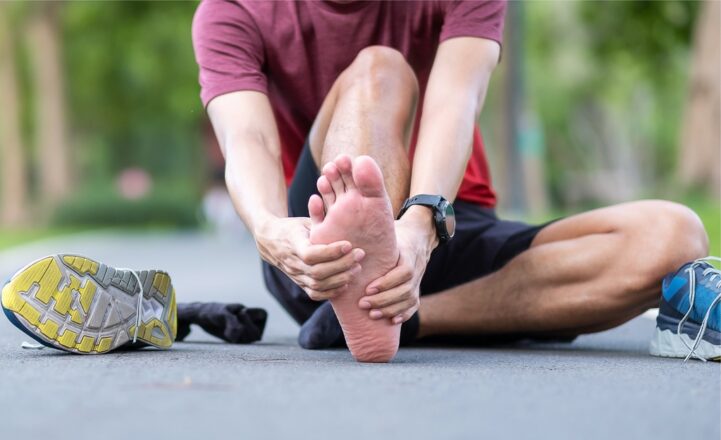Sharp stabbing pain in the morning as you make your first steps? Or pain after running? It could be plantar fasciitis.
Many runners complain about plantar fasciitis being so bad that they can’t walk. Plantar fasciitis is one of the most common running injuries.
No surprise there since the condition can result due to repeated stress placed on the feet. Whether that’s overtraining or simply running too much.
So, how to cure plantar fasciitis in one week or at least relieve the pain? Read on to find out. We’ll also look at what causes plantar fasciitis and the most effective plantar fasciitis stretches and exercises.
In This Article
In This Article:
What Is Plantar Fasciitis?
Plantar fasciitis happens when the tendons that support the arch in your foot, connecting the toes to the heel, become inflamed. It can lead to severe pain at the bottom of the foot and especially under the heel.
It’s a foot injury common among runners, athletes, and people who are overweight or have high-arched feet. It’s also more likely to affect people who are middle-aged or older. This happens because, with age, the fascia tendons lose their elasticity.
So, what causes plantar fasciitis?
Straining, stressing, or simply overusing the plantar fascia can cause inflammation. High-impact activities, such as sports or endurance running, are common culprits.
People with high-arched feet are more likely to develop the condition. Using inadequate shoes, such as running shoes that don’t provide good cushioning, can also increase the risk of developing plantar fasciitis.
The condition typically resolves with proper treatment. But the path to recovery can take months. Some people with the condition can go on to develop chronic plantar fasciitis.
What Are the Symptoms of Plantar Fasciitis?
The characteristic symptom of plantar fasciitis is stabbing pain near the heel. The pain can be especially intense during the first steps you take in the morning after getting out of bed.
Or when you get up from a chair or couch after sitting. This happens because, during periods of inactivity, the plantar fascia becomes tighter and shorter. Standing for an extended period may also trigger plantar fasciitis pain.
The pain typically lessens as you move or exercise as this stretches the plantar fascia. You may then experience it as a dull, constant ache that becomes sharp when you put pressure on your heel.
Other plantar fasciitis symptoms can include:
- Pain in the arch of the foot
- Swelling around the heel
- Taut Achilles tendon
- Stiffness
How to Get Early Relief From Plantar Fasciitis?
A case study suggests that combining different plantar fasciitis treatment methods can help address the acute and chronic symptoms of the condition. Here are some of the most effective strategies for dealing with plantar fasciitis.
Rest
As with most injuries, rest is a crucial component of the recovery process. Regardless of the other therapies you use, it’s crucial to refrain from further stressing your plantar fascia.
In most cases, this means giving up on exercising for at least a week. And since each time you stand, walk, or cycle, you put tension on the plantar fascia, it’s best to refrain from walking too much.
Try to reduce your step count as much as possible while your plantar fascia heals. As you begin to recover, ease your way gently into exercise. For example, you can cycle or swim instead of running as these activities put less stress on your feet.
At the very least, avoid placing weight on your injured foot until the inflammation subsides.
Compression socks and night splints
During sleep, the plantar fascia becomes tighter and shorter, which can result in severe pain during the first steps you take in the morning. The same may happen if you sit for long periods.
Compression socks and night splits can help with this. Night splints are an established treatment method for plantar fasciitis among podiatrists – doctors who treat conditions of the feet or lower legs. The purpose of night splints is to maintain the length of the plantar fascia while you sleep.
Meanwhile, you can wear compression socks throughout the day. These socks can help increase blood flow, decrease soreness, reduce swelling, and boost support for the arches of the foot.
Using night splints alongside icing, compression stocking, stretching exercises, and other therapies can help reduce pain and promote recovery.
Stretching exercises
A 2019 randomized controlled trial found that strengthening and stretching exercises can reduce pain associated with the condition.
These findings support the results of an earlier trial, which found that specific stretching exercises improve the outcome of chronic plantar fasciitis.
Research from 2010 shows that plantar fasciitis patients who perform a specific stretching exercise 3 times a day for 8 weeks recover better. Here’s how to do this stretch:
1. Sit down on a chair and cross your plantar fasciitis foot over your other leg’s knee.
2. Hold the toes of the affected foot with your fingers and bring them up even as you bring the ankle up.
3. Rub your thumb along the bottom of your foot. This will stretch the plantar fascia, which should feel like a tight band.
4. Hold the stretch for 10 seconds.
5. Repeat 10–20 times for each foot.
It’s best to do this exercise first thing in the morning and after long periods of sitting.
A few other plantar fasciitis stretches can also provide relief:
- Towel stretch. Do this exercise before getting out of bed. Sit on the bed with the affected leg straight. Place a towel around your foot and pull it by the ends with both hands toward you gently. Hold the stretch for 45 seconds. Repeat up to 3 times.
- Rolling stretch. For this stretch, you need an exercise ball or water bottle. Place the ball or bottle (filled) on the floor and put your painful foot on it. Apply gentle pressure on the ball or bottle and roll your foot and ankle slowly against it. If you’re using an exercise ball, move your foot in a circular motion. Do this for 1 minute.
- Book stretch. Place a hardback two feet away from a wall. Stand on the book so that your heels hang over the edge. Lean forward slowly with your hands in front until your hands meet the wall and support your weight. Maintain the position for 15 seconds and lift your feet up and down using the balls of your feet. Keep your back straight.
Massage
Massage can help relax the muscles of your foot, providing relief from the pain. It can also increase blood flow and break fascia tears that haven’t healed properly. But avoid massaging the heel directly as it can compress the plantar fascia and worsen the pain.
A simple way to massage your foot is to use a golf or tennis ball.
1. Sit down and place the ball on the floor in front of you.
2. Place your affected foot on the ball.
3. Roll the ball under your foot, applying steady pressure.
4. If you reach a tender area, apply steady pressure for a few seconds, being careful to avoid causing sharp pain.
Applying an ice pack
Research indicates that applying ice on injuries such as plantar fasciitis may help in their treatment. Ice treatments appear to be especially effective when used alongside rehabilitation exercises.
However, more research is needed to determine the optimal mode of application or duration of ice treatment for plantar fasciitis.
To make an ice pack at home, place a bag of frozen veggies or fruits in a plastic zip bag. Apply it to the heel and any other painful area for up to 15 minutes for a quick analgesic. Repeat up to 4 times a day.
Proper shoe inserts
Orthotic shoe inserts provide your injured foot with support and extra cushioning. You can easily add them to your running shoes and most other footwear.
You can find insoles specially developed for plantar fasciitis over the counter. So no need to have them custom-made. Look for firm shoe inserts that provide good arch support.
Arch taping
Arch taping provides support to your foot. It can help prevent you from moving your foot in ways that worsen the pain.
For arch taping, you can use kinesiology tape or other types of elastic therapeutic tape.
To apply the tape, follow these steps:
1. With the tape, measure the distance from the ball of your foot to the back of your heel.
2. Cut the tap according to your measurements and then cut this tape into 4 strips and round their edges.
3. Also, with the tape, measure the length of the ball of your foot and cut the tape accordingly. Further, cut this piece of tape into four more strips. Again, round their edges.
4. Lay the first four strips over the arch of your foot and rub them into place.
5. Secure the strips in place by placing the second piece of tape on the ball of your foot.
Other therapies you can consider
A study of 29 men and women with plantar fasciitis investigated the efficiency of dry cupping and electrical stimulation therapy. Patients were divided into two groups, each receiving one of the treatments twice a week for 4 weeks.
Researchers found that both treatment options reduced plantar fasciitis pain and improved function. If you experience severe symptoms, you may want to consider these treatment options.
So, Can One Cure Plantar Fasciitis in One Week?
Your body needs more than a week to fully recover from plantar fasciitis. It may take 6 months or longer for your body to make a full recovery.
Forcing a recovery too fast will only bring the pain back or make the injury worse. If you have plantar fasciitis, you need to give your body time to recover.
With that in mind, it’s possible to cure the more unpleasant plantar fasciitis symptoms in as little as one week. Follow the therapies we recommended above, and you should see a rapid improvement in symptoms.
Signs plantar fasciitis is healing include:
- Less and less pain in the morning
- Decrease in overall pain
- Localized pain only
- Returning range of motion
Takeaways
In the end, here are a few key things to remember:
- You cannot cure plantar fasciitis in one week.
- But you can find relief from the more unpleasant plantar fasciitis symptoms in as little as a week or even sooner.
- Combining multiple therapies provides better results than focusing on only one therapy.
- Rest and then reduce the frequency and intensity of exercise to make a full recovery.
- Effective plantar fasciitis physical therapy includes massaging, arch taping, and stretching exercises.
References:
- Cullen, N.P. and Singh, D., 2006. Plantar fasciitis: a review. British Journal of Hospital Medicine (2005), 67(2), pp.72-76.
- Rolf, C., Guntner, P., Ericsäter, J. and Turan, I., 1997. Plantar fascia rupture: diagnosis and treatment. The Journal of foot and ankle surgery, 36(2), pp.112-114.
- Batt, M.E., Tanji, J.L. and Skattum, N., 1996. Plantar fasciitis: a prospective randomized clinical trial of the tension night splint. Clinical Journal of Sport Medicine, 6(3), pp.158-162.
- Steinmetz, M. and Barrett, S.L., 1999. Treatment choices for plantar fasciitis/In reply. American Family Physician, 60(9), p.2504.
- Sammarco, G.J. and Helfrey, R.B., 1996. Surgical treatment of recalcitrant plantar fasciitis. Foot & ankle international, 17(9), pp.520-526.
- Gill, L.H., 1997. Plantar fasciitis: diagnosis and conservative management. JAAOS-Journal of the American Academy of Orthopaedic Surgeons, 5(2), pp.109-117.














